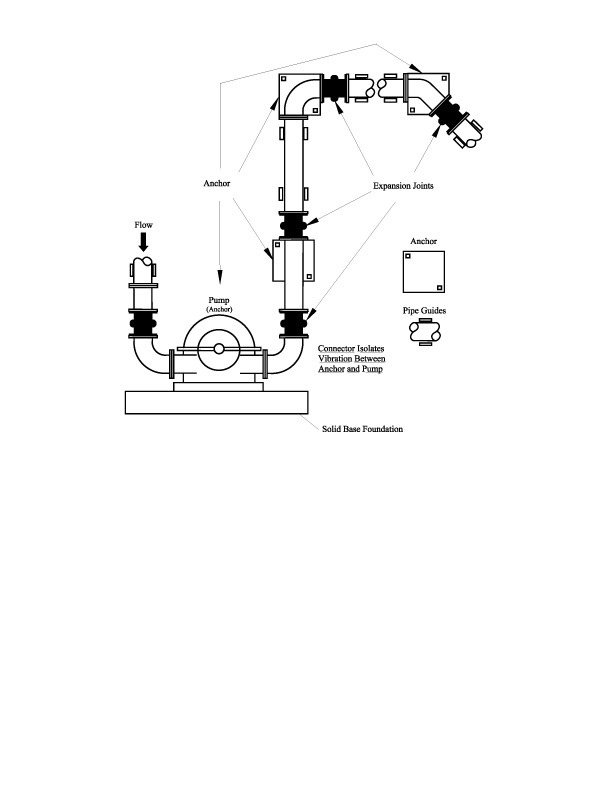What should be considered for the selection of expansion joints for pumps?
This month’s “Sealing Sense” was prepared by FSA member Bud Baltzer.
Some past “Sealing Sense” articles have focused on important considerations when replacing a failed expansion joint or pump flexible connector. While defining all the possible causes of a failure is important, doing everything possible to get it right the first time is equally important. This can save the end user money and time by delaying significant replacement costs and failures.
All components and system requirements must be considered when choosing an expansion joint for the particular application. Uncovering all the factors that may influence reliable performance provides for the most ideal selection.
Piping Plan
 Before addressing the expansion joint itself, ensure that adjacent piping and equipment conforms to Good, solid piping engineering practices. Basically, this means the proper placement and design of the anchors, guides and supports are important for the expansion joint to function properly.
Before addressing the expansion joint itself, ensure that adjacent piping and equipment conforms to Good, solid piping engineering practices. Basically, this means the proper placement and design of the anchors, guides and supports are important for the expansion joint to function properly.
An explanation of good practice can be found in both FSA’s Piping Expansion Joint Technical Handbook (Non-Metallic) and EJMA Standards Handbook (Metallic).
A typical pump piping arrangement is shown in Figure 1. The publications above should be consulted for complete design recommendations. Piping arrangements are only briefly reviewed here due to space constraints.
Joint Movement
Since expansion joints and pump flexible connectors are employed to absorb axial, lateral and angular pipe movement, as well as vibration, careful consideration should be made to correctly calculate those movements. It is important that the correct coefficient of thermal expansion (CTE) is used.
The specific pipe material must be known since the CTE differs greatly between pipe materials. These differences can affect calculated movement to a point that the pipe movement may greatly exceed the expansion joint’s capability when initial calculations show that they are within its limits.
Pumped Media
Determining the process media is also important since new chemicals are processed every year. The media is one of the most important determining factors for compatible elastomer selection. Material selection must not be compromised during the specifying process. Choosing a marginal tube material is risky and invites high replacement costs and/or downtime.
Any abrasive material in the media should also be investigated since even minute amounts of abrasive material at high velocity can wear out a tube prematurely. A protective liner or filled arch design should be investigated. Conservatism is the best policy since a compromised product can lead to rapid deterioration and failure.
It is recommended that severe service joints carry material certification requirements and that material properties are checked to confirm that the material certification matched the pumped fluid.
The recently updated Standard FSA-PSJ-703-11 Guidelines for Elastomers Used in Piping Systems Non-Metallic Expansion Joints provides insight into proper selection of the tube and cover compounds.
Pressure and Temperature
Accurate temperature and pressure data is important and should be included in the analysis of the application’s requirements. When temperatures exceed 200 degrees Fahrenheit (93 degrees Celsius), proper pressure de-rating should be made to ensure that the expansion joint or flexible connector can handle the system working pressure at the maximum elevated temperature. Pressure de-rating is required to prevent potential deterioration of the reinforcing fabric.
When connectors are used at the pump discharge, pulsating or shock pressure should be investigated. A general rule is that the expansion joint or flexible connector should be rated to withstand four times the system working to compensate for shock pressure.
High quality, reliable anchors should be employed that will withstand the joint pressure thrust and force resulting from the pipe motion. The use of control rods or limit bolts is also recommended as a backup for the possibility of anchor failure. These rods prevent the joint from extending or pulling apart if a restraint anchor were to fail or blow out. The use of control rods is an inexpensive insurance policy.
Case Study—Properly Designed and Applied Expansion Joint
Non-metallic expansion joint systems, when designed properly and applied correctly, can last 30 years or more. One example is an application in which high pressure cooling water was passing through an ethylene propylene diene monomer (EPDM)expansion joint with a 132-inch internal diameter at more than 200 degrees F (93 degrees C) in a nuclear power facility. When removed, the expansion joint showed little wear and increased durometer hardness after more than 25 years of service.
Reliability is almost always tied directly to correct joint selection along with sound adjacent piping design. Consideration of all factors that can affect performance will almost guarantee long life for expansion joints or flexible connectors.
Next Month: Why are mechanical seals still the preferred choice in process industries?
We invite your questions on sealing issues and will provide best effort answers based on FSA publications. Please direct your questions to: sealingsensequestions@fluidsealing.com.
P&S

